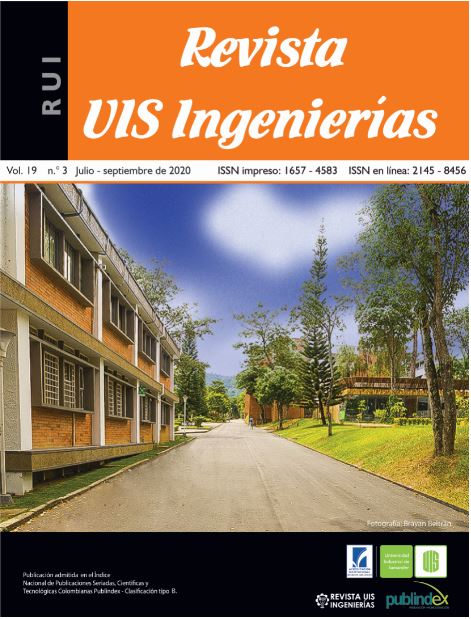Study of oil-water fluids through of the sensor based on the electrical permittivity of the fluid pattern
Published 2020-06-01
Keywords
- WMS,
- multiphase,
- tomography,
- permittivity,
- flow pattern
How to Cite
Copyright (c) 2020 Revista UIS Ingenierías

This work is licensed under a Creative Commons Attribution-NoDerivatives 4.0 International License.
Abstract
A sensor based on the electrical permittivity of the fluid was used to analyze the tomographies of the different patterns that appear in multiphase oil and water flow (Liquid-Liquid). The experimental study was carried out in a borosilicate glass tube with an internal diameter of 25.4 [mm] and length of 12 [m]. The sensor is made up of two 8 x 8 wire flat wire mesh called a wire mesh sensor (WMS). The experiments were carried out with two different oil viscosities, one with 200 [cP] and the other with 60 [cP] at 860 [kg / m3]density with the tube positioned horizontally and slightly inclined at + 5 degrees, to vary the viscosity of the oil, a heat exchanger was used. The analyzed multiphase flow pattern was annular, stratified and dispersed. The tomographies obtained by the WMS were compared with a high-speed camera for the qualitative validation of the results. Twelve models of electrical permittivity were used to study the current fluid regime.
Downloads
References
[2] S. Arirachakaran, K. D. Oglesby, M. S. Malinowsky, O. Shoham, J. P. Brill, “An Analysis of Oil/Water Flow Phenomena in Horizontal Pipes”, en SPE Production Operations Symposium, Apr. 1989, doi: 10.2118/18836-MS
[3] M. Nädler, D. Mewes, “Flow induced emulsification in the flow of two immiscible liquids in horizontal pipes,” Int. J. Multiph. Flow, vol. 23, no. 1, pp. 55-68, 1997, doi: 10.1016/S0301-9322(96)00055-9
[4] P. Angeli, G. F. Hewitt, “Pressure gradient in horizontal liquid-liquid flows,” Int. J. Multiph. Flow, vol. 24, no. 7, pp. 1183–1203, 1998, doi: 10.1016/S0301-9322(98)00006-8
[5] O. M. H. Rodriguez, I. H. Rodriguez, J. L. Ansoni, “An experimental and numerical study on the wall lubrication force in dispersed liquid-liquid flow,” Int. J. Multiph. Flow, vol. 120, 2019, doi: 10.1016/j.ijmultiphaseflow.2019.103094
[6] J. Lovick, P. Angeli, “Experimental studies on the dual continuous flow pattern in oil-water flows,” Int. J. Multiph. Flow, vol. 30, no. 2, pp. 139–157, 2004, doi: 10.1016/j.ijmultiphaseflow.2003.11.011
[7] K. Ioannou, O. J. Nydal, and P. Angeli, “Phase inversion in dispersed liquid-liquid flows,” Exp. Therm. Fluid Sci., vol. 29, no. 3, pp. 331–339, 2005, doi: 10.1016/j.expthermflusci.2004.05.003
[8] J. Y. L. Lum, T. Al-Wahaibi, P. Angeli, “Upward and downward inclination oil-water flows,” Int. J. Multiph. Flow, vol. 32, no. 4, pp. 413–435, 2006, doi: 10.1016/j.ijmultiphaseflow.2006.01.001.
[9] H. F. Velasco Peña, A. Bonilla Riaño, C. H. Monteiro De Carvalho, V. Estevam, O. M. Hernandez Rodriguez, “Wire-mesh-based tomography in upward-vertical oil-water-air three-phase flow,” ICMF 2016, 2016.
[10] M. Hernandez-cely, A. F. D. A. Teixeira, R. H. Ruschel, “Estimation of Permittivity Models for Holdup Measurement of Viscous-Oil for different patterns,” 2019 Int. Conf. Control. Autom. Diagnosis, pp. 1–6, 2019, doi: 10.1109 / ICCAD46983.2019.9037921
[11] M. J. Da Silva, E. Schleicher, U. Hampel, “Capacitance wire-mesh sensor for fast measurement of phase fraction distributions,” Meas. Sci. Technol., vol. 18, no. 7, pp. 2245–2251, Jul. 2007.
[12] I. H. Rodriguez, H. K. B. Yamaguti, M. S. de Castro, M. J. Da Silva, O. M. H. Rodriguez, “Slip ratio in dispersed viscous oil-water pipe flow,” Exp. Therm. Fluid Sci., vol. 35, no. 1, pp. 11–19, 2011, doi: 10.1016/j.expthermflusci.2010.07.017
[13] O. M. H. Velasco Peña, H.F. Bonilla Riaño, A. Rodriguez, I.H. Rodríguez, “Evaluation of permittivity models for holdup measurement of viscous-oil in water dispersed flow,” in 8th International Conference on Multiphase Flow ICMF 2013, 2013, p. 2013.
[14] I. D. Johnson, “Method and apparatus for measuring water in crude oil,” U.S. Pat. 4664263, 1987.
[15] H. F. Velasco Peña, O. M. H. Rodriguez, “Applications of wire-mesh sensors in multiphase flows,” Flow Meas. Instrum., vol. 45, pp. 255–273, 2015, doi: 10.1016/j.flowmeasinst.2015.06.024
[16] I. H. Rodriguez, H. F. Velasco Peña, A. Bonilla Riaño, R. A. W. M. Henkes, O. M. H. Rodriguez, “Experiments with a Wire-Mesh Sensor for stratified and dispersed oil-brine pipe flow,” Int. J. Multiph. Flow, vol. 70, pp. 113–125, 2015, doi: 10.1016/j.ijmultiphaseflow.2014.11.011
[17] T. Frøystein, H. K. Kvandal, H. Aakre, “Dual energy gamma tomography system for high pressure multiphase flow,” Flow Meas. Instrum., vol. 16, no. 2–3, pp. 99–112, 2005, doi: 10.1016/j.flowmeasinst.2005.02.005
[18] M. Appel, J. J. Freeman, D. Pusiol, “Robust multi-phase flow measurement using magnetic resonance technology,” SPE Middle East Oil Gas Show Conf. MEOS, Proc., vol. 2, no. January, pp. 932–951, 2011, doi: 10.2118/141465-MS.
[19] Y. Li et al., “Gas/oil/water flow measurement by electrical capacitance tomography,” Meas. Sci. Technol., vol. 24, no. 7, 2013, doi: 10.1088/0957-0233/24/7/074001
[20] B. Wang, Z. Gui, W. Tan, Z. Huang, H. Ji, H. Li, “A new dual-modality ECT/ERT technique based on C4D principle,” Conf. Rec. - IEEE Instrum. Meas. Technol. Conf., vol. 2015-July, pp. 2061–2065, 2015, doi: 10.1109/I2MTC.2015.7151600
[21] H.-M. Prasser, A. Böttger, J. Zschau, “A new electrode-mesh tomograph for gas-liquid flows,” FLOW Meas. Instrum., vol. 9, no. 2, pp. 111–119, Jun. 1998, doi: 10.1016/S0955-5986(98)00015-6
[22] H. Looyenga, “Dielectric constants of heterogeneous mixtures,” Physica, vol. 31, no. 3, pp. 401–406, 2002, doi: 10.1016/0031-8914(65)90045-5
[23] T. Hao, “Dielectric Properties of Non-aqueous Heterogeneous Systems,” Semental. Interface Sci., vol. 22, pp. 341 - 423, 2005.
